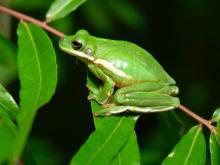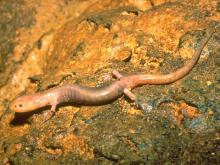Reptiles and Amphibians
Media

Species Types
Scientific Name
Hyla cinerea (syn. Dryophytes cinereus)
Description
The bright green treefrog hides perfectly among cattail leaves, where it rests until evening. Then it begins hunting for insects. In Missouri, it occurs mostly in the Bootheel.
Media

Species Types
Scientific Name
Hemidactylium scutatum
Description
A glacial relict in Missouri’s eastern Ozarks, the four-toed salamander lives among mosses in heavily forested streams and creeks and sinkhole ponds. It has a thick, round tail that is constricted at its base. There are four toes on each limb.
Media

Species Types
Scientific Name
Plethodon albagula
Description
The western slimy salamander is a black to blue-black salamander irregularly marked with silvery flecks. It occurs in the Ozark Highlands and the Lincoln Hills north of the Missouri River. True to its name, it secretes a thick substance that sticks to skin like glue.
Media

Species Types
Scientific Name
Opheodrys aestivus aestivus
Description
The northern rough greensnake is a long, slender snake common in the Ozarks. It is light green above with a white or yellowish belly. The scales on the back have small ridges that feel rough to the touch. Its beautiful green color helps this mild-mannered insectivore blend in with tree leaves.
Media

Species Types
Scientific Name
Eurycea spelaea
Description
The grotto salamander is Missouri’s only species of blind salamander. A true troglobite, it lives in total darkness and has small eyes that are completely or partially covered by their pink or beige skin. Occurs in wet caves in the Ozarks.
See Also
About Reptiles and Amphibians in Missouri
Missouri’s herptiles comprise 43 amphibians and 75 reptiles. Amphibians, including salamanders, toads, and frogs, are vertebrate animals that spend at least part of their life cycle in water. They usually have moist skin, lack scales or claws, and are ectothermal (cold-blooded), so they do not produce their own body heat the way birds and mammals do. Reptiles, including turtles, lizards, and snakes, are also vertebrates, and most are ectothermal, but unlike amphibians, reptiles have dry skin with scales, the ones with legs have claws, and they do not have to live part of their lives in water.





















